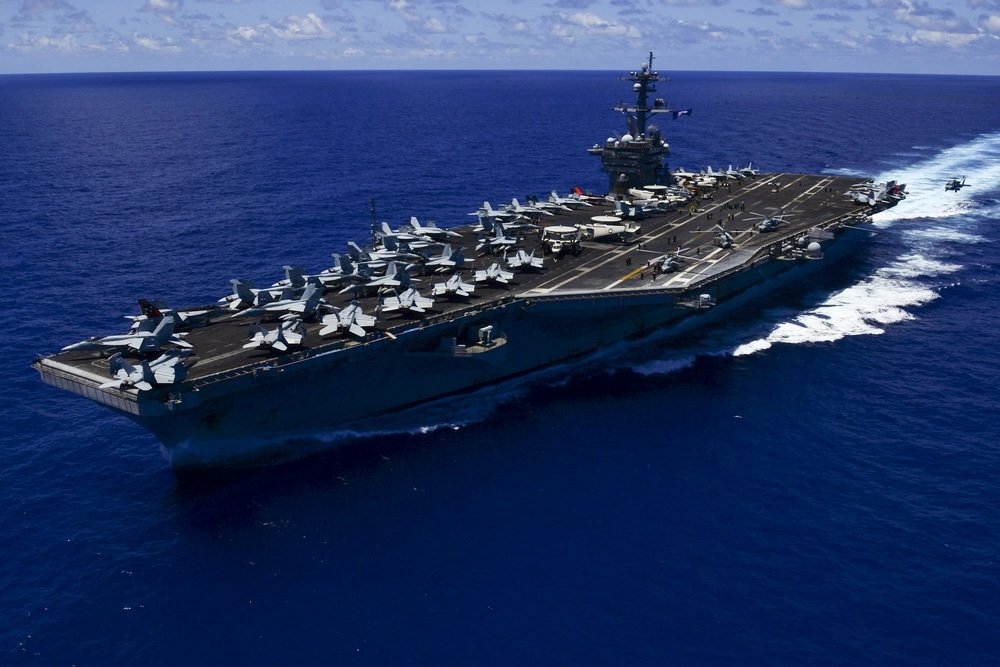
Key points
- Those calling for Washington toe expand U.S. military presence in the Western Pacific have misread the regional security environment. The United States can reduce its military footprint in East Asia without jeopardizing its national security of the stability of the region.
- China is not poised to dominate East Asia or any other part of the Indo-Pacific region. While the distribution of power in East Asia has shifted in favor of Beijing, it does not follow that China constitutes a major threat to the territorial integrity or political independence of all neighboring states.
- Regional powers can deter China from launching wars of aggression by investing in the right kinds of defensive weaponry to capitalize on geographic advantages. The United States should play the role of an “offshore balancer” by helping China’s neighbors to become more resilient to coercion from Beijing.
- The leaders of several prominent states in East Asia are anxious to avoid a “cold war” between the United States and China. Washington should heed their calls for restraint. Pushing these governments to choose a side in the U.S.-China rivalry would needlessly antagonize them.
- The issue of Taiwanese security presents a special challenge for the United States and its allies. Taiwan has the most to lose from China’s rise and perceives U.S. military support as essential to its survival as a defacto independent entity. However, the United States can retrench from East Asia without “abandoning” Taiwan to China.
- Peace in East Asia and the wider Indo-Pacific does not depend upon the United States enjoying primacy in the region. On the contrary, the pursuit of U.S. military primacy in the Western Pacific will make it more difficult to maintain regional security and promote economic prosperity over the long term.
What America wants in East Asia
The distribution of power in the Western Pacific has been shifting in China’s favor for the past several decades. The popular view in Washington is that the United States must counteract these adverse shifts in power via a strategy of military primacy in East Asia—that is, the pursuit of local military superiority in all possible theaters of Asia by U.S. forces.1Michael Beckley and Hal Brands, Danger Zone: The Coming Conflict with China (New York, NY: W.W. Norton, 2022); Elbridge Colby, The Strategy of Denial: American Defense in an Age of Great Power Conflict (Yale, CT: Yale University Press). Cf. Joshua R. Itzkowitz Shifrinson, “Neo-Primacy and the Pitfalls of U.S. Strategy toward China,” Washington Quarterly 43, no. 4 (2020): 79–104. This view is misguided. Primacy should not be considered a desirable end in itself, nor is it necessary to secure U.S. policy goals in East Asia.2Daniel Drezner, “Military Primacy Doesn’t Pay (Nearly As Much As You Think),” International Security 38, no. 1 (2013): 52–79.
For present purposes, America’s policy priorities in East Asia can be defined as follows:
- Prevent the outbreak of a major war in East Asia, especially one involving a treaty ally.
- Preserve the territorial status quo, except for amendments made via the peaceful resolution of existing boundary disputes.
- Dissuade any large country or regional bloc from embracing economic autarky.
These are the de facto priorities of the United States today. To be sure, some analysts have expressed concern that these priorities are too expansive, arguing that Washington should trim its foreign-policy goals to make them less ambitious than even these spare objectives.3Charles L. Glaser, “Washington Is Avoiding the Tough Questions on Taiwan and China,” Foreign Affairs, April 28, 2021, https://www.foreignaffairs.com/articles/asia/2021-04-28/washington-avoiding-tough-questions-taiwan-and-china. This is a reasonable and defensible view. The point, however, is that military primacy is an unnecessary aspiration even when it is accepted that the United States has significant policy priorities in the region.
America’s most obvious policy goal in the Western Pacific is to avoid the eruption of a major war. While the risk of an interstate conflict in East Asia is relatively low, four simmering disputes have the potential to metastasize into a sizable war if not handled correctly: the conflict on the Korean Peninsula, the Sino-Japanese dispute over the Senkaku/Diaoyu Islands in the East China Sea, the various territorial and maritime disputes in the South China Sea, and the problem of Taiwan’s political status.4Brendan Taylor, The Four Flashpoints: How Asia Goes To War (Carlton, AU: LaTrobe University Press/Black Inc Books, 2018). On the differences between territorial and maritime sovereignty disputes, see Bec Strating, “Maritime and Sovereignty Disputes in the East China Sea,” Maritime Awareness Project, February 9, 2021, https://www.nbr.org/publication/maritime-and-sovereignty-disputes-in-the-east-china-sea/. Three of these disputes involve U.S. treaty allies.5While Taiwan is not a treaty ally of the United States, the U.S. military could become embroiled in a war over Taiwan if Chinese forces attacked U.S. positions in a preemptive attack or if a sitting U.S. president decided that joining the war was in the national interest, especially if facing political pressure in Washington and if given military advice that a war could be kept “limited” and “winnable.” Outside of East Asia proper, there is also a low-level risk that China might choose to resolve its boundary disputes with India and Bhutan by using overwhelming force.6Between May 2020 and January 2021 (and again in December 2022), Chinese and Indian forces engaged in direct combat along the Line of Actual Control that separates them in contested Himalayan regions. Twenty Indian and four Chinese soldiers were killed.
South China Sea dispute
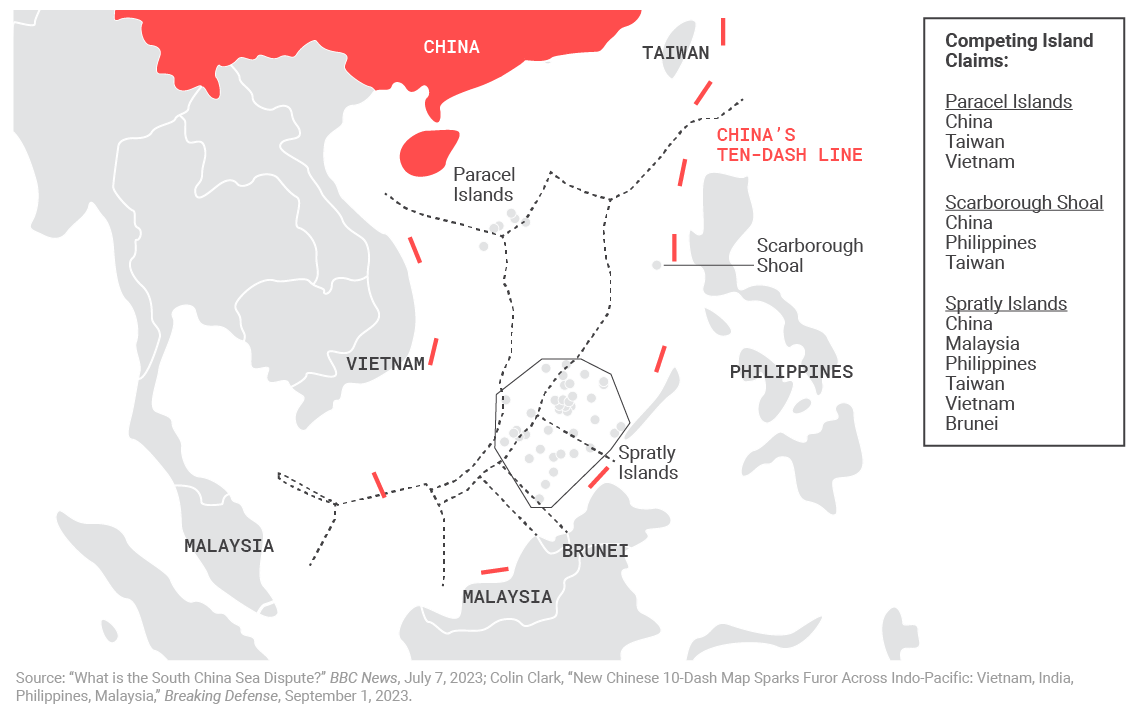
The South China Sea is a potential flashpoint for conflict in Asia. China, Taiwan, Vietnam, Malaysia, Brunei, and the Philippines all have overlapping maritime claims related to their territorial seas and exclusive economic zones.
The economic consequences for U.S. firms and consumers could be severe if any of these disagreements were to grow into a full-blown war.7There is an alternative view, however, that the costs of war to the U.S. economy could be modest. This argument is rooted in an expectation that the globalized world economy is quite resilient and the finding that neutral countries have not, historically, suffered massive economic costs as a result of third parties’ wars. See Eugene Gholz and Daryl G. Press, “The Effects of Wars on Neutral Countries: Why It Doesn’t Pay to Preserve the Peace,” Security Studies 10, no. 4 (2001): 1–57. This would be especially true if maritime East Asia became engulfed in conflict, given the significance of the region for international commerce. According to researchers at the Center for Strategic & International Studies, approximately one-third of all global shipping passes through the South China Sea.8China Power Project, “How Much Trade Transits the South China Sea?” Center for Strategic and International Studies, January 25, 2021, https://chinapower.csis.org/much-trade-transits-south-china-sea/. Disruption of these trade flows would negatively impact the U.S. economy, as higher transportation costs and shortages of goods would lead to inflated prices.9The point is not that goods bound to North America travel through the South China Sea. Obviously, most U.S. trade with East Asia traverses the Pacific Ocean. But the U.S. economy would nevertheless be affected by the global increases in prices that would occur as a result of war—an outcome previewed by the war in Ukraine, which resulted in major disruptions to grain exports from Ukraine and energy exports from Russia. The economic costs of war would be even higher if the United States and its allies chose to impose sanctions, embargoes, or other restrictions on belligerent nations.10Gerard DiPippo and Jude Blanchette, “Sunk Costs: The Difficulty of Using Sanctions to Deter China in a Taiwan Crisis,” Center for Strategic & International Studies, June 12, 2023, https://www.csis.org/analysis/sunk-costs-difficulty-using-sanctions-deter-china-taiwan-crisis.
Beyond the possible economic impact of a war in East Asia, there is also a nontrivial risk that the United States could become embroiled in any of the four disputes noted above. After all, the United States is a treaty ally of South Korea, Japan, and the Philippines, and Washington has looser strategic relationships with several other countries that are engaged in boundary disputes with China (India, Brunei, Indonesia, Malaysia, and Vietnam, as well as Taiwan).11In Asia, the United States is also a treaty ally of Thailand and Australia. Neither state is currently involved in a territorial dispute, however. The relationship with Taiwan is particularly salient in U.S. domestic politics given that the Taiwan Relations Act legally defines “any effort to determine the future of Taiwan by other than peaceful means” as “of grave concern to the United States.” See Taiwan Relations Act, Pub. L No. 96–8 (1979), https://www.congress.gov/96/statute/STATUTE-93/STATUTE-93-Pg14.pdf. While the U.S. government would always retain the final say over whether to join a war in Asia, it could be politically difficult—and perhaps very costly—for a sitting president to stay out of a war that involved a treaty ally or close strategic partner.12Michael Tomz and Jessica L.P. Weeks, “Military Alliances and Public Support for War,” International Studies Quarterly 65, no. 3 (2021): 811–824. It follows that U.S. leaders have a strong incentive to avoid war in the first place.
As well as preventing the outbreak of a major war, the United States has a related policy goal of seeing that the territorial settlement in East Asia is not revised to the lopsided advantage of China.13This is conceptually distinct from America’s interest in avoiding war in East Asia because not all wars result in territorial changes and not all coerced territorial changes are the result of wars. Sometimes, just the threat of war is enough to bring about a forced change to national frontiers. Of course, the U.S. interest in upholding East Asia’s territorial status quo has limits; not all borders are of equal importance to the United States, and national frontiers are sometimes amended in ways that benefit all parties concerned. Nevertheless, Washington has a general policy of opposing the use or threat of force to revise the territorial status quo and has a deeper interest in seeing that economically powerful regions of East Asia do not fall under the sway of a hostile power.14At the present time, there is a vanishingly small chance that China could—or would attempt to—invade and conquer a rich and powerful nation such as South Korea or Japan. Still, it would be remiss not to point out that U.S. policy since 1945 has been oriented toward denying any hostile power—first the Soviet Union, then China—the opportunity to bring the economic power and potential of East Asia under its control. This remains an overarching objective of U.S. foreign policy.
U.S. trade volume with China, 2000-2022
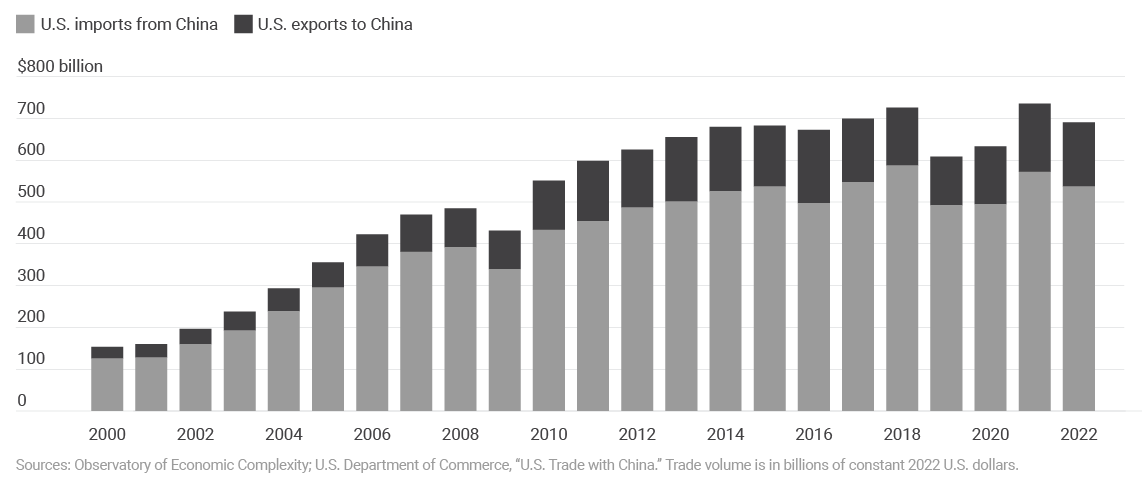
Despite increasing geopolitical tensions, bilateral trade between the United States and China remains robust. Last year, bilateral trade volume peaked at over $700 billion. A conflict would be economically devastating for both countries.
To be clear, Washington’s general interest in upholding the territorial status quo in East Asia does not mean that the United States should support the freezing of all territorial conflicts. On the contrary, it is broadly in the U.S. national interest for territorial disputes to be resolved, even if this means endorsing changes to national frontiers—so long as those disputes are resolved through peaceful means. In most cases, the United States should remain impartial about how disputed territories ought to be divided among rival claimants. What matters to Washington is that territorial disputes are settled using appropriate international mechanisms rather than force.15Even when it comes to Taiwan, the official policy of the U.S. government is that the status of Taiwan is “undetermined” and ought to be resolved through peaceful negotiations, which implies that the United States would acquiesce in the integration of Taiwan into the People’s Republic of China if this option were to be chosen by both sides of the Strait. This agnosticism is the proper approach to East Asia’s territorial disputes.
The final policy priority of the United States in East Asia is to maintain an open regional economy. Despite a much-discussed turn toward economic nationalism in the United States, the reality is that the U.S. economy still depends in large part upon access to overseas trade and investment opportunities. Access to markets in East Asia is critically important to economic growth in the United States. Of America’s top ten trading partners in 2021, six were in Asia: China, Japan, South Korea, Taiwan, India, and Vietnam.16Ken Roberts, “For First Time, Majority Of Top 10 U.S. Trade Partners Will Be Asian,” Forbes, January 28, 2022, https://www.forbes.com/sites/kenroberts/2022/01/28/for-first-time-majority-of-top-10-us-trade-partners-will-be-asian/. Moreover, U.S. firms currently hold almost $1 trillion worth of investments in Asia, a number that has nearly doubled in the past 10 years.17The White House, “FACT SHEET: In Asia, President Biden and a Dozen Indo-Pacific Partners Launch the Indo-Pacific Economic Framework for Prosperity,” May 23, 2022, https://www.whitehouse.gov/briefing-room/statements-releases/2022/05/23/fact-sheet-in-asia-president-biden-and-a-dozen-indo-pacific-partners-launch-the-indo-pacific-economic-framework-for-prosperity/. The U.S. government estimates that “more than three million” U.S. jobs depend upon trade with Asia.18The White House, “FACT SHEET: In Asia, President Biden and a Dozen Indo-Pacific Partners Launch the Indo-Pacific Economic Framework for Prosperity.”
Given the importance of East Asian economies to U.S. prosperity, it is a high priority for the United States that East Asia remains oriented toward economic openness. This includes the Chinese economy. As Treasury Secretary Janet Yellen explained in April 2023, U.S. policy toward China is to pursue “healthy economic engagement that benefits both countries.”19U.S. Department of the Treasury, “Remarks by Secretary of the Treasury Janet L. Yellen on the U.S.-China Economic Relationship at Johns Hopkins School of Advanced International Studies,” April 20, 2023, https://home.treasury.gov/news/press-releases/jy1425. At least under President Joe Biden, the goal is to encourage strong flows of bilateral trade and investment even as Washington has introduced stringent curbs on the export of high-end semiconductors to the Chinese market.20Laura He, “U.S. Curbs on Microchips Could Throttle China’s Ambitions and Escalate the Tech War,” CNN, October 31, 2022, https://www.cnn.com/2022/10/31/tech/us-sanctions-chips-china-xi-tech-ambitions-intl-hnk/index.html.
Whether this Janus-faced economic policy (blending targeted sanctions against China with an overall push for economic cooperation) will prove workable into the future remains to be seen, but it is nevertheless a clear policy objective of the U.S. government today to discourage China and other regional powers from turning inward. Simply put, it would be hugely detrimental to U.S. interests if the Western Pacific’s major economies were to embrace protectionism or economic autarky, whether as individual states or as a group.
The case for offshore balancing
The U.S. policy goals described above are essentially “defensive” in nature.21Eugene Gholz, Benjamin Friedman, and Enea Gjoza, “Defensive Defense: A Better Way to Protect U.S. Allies in Asia,” Washington Quarterly 42, no. 4 (2019): 171–189. To some, this implies that the United States must maintain a vast military presence in East Asia to prevent a rising China from being able to overturn the regional architecture that the United States has long benefitted from.22See, for example, Colby, The Strategy of Denial. Those who endorse this position believe that Washington will be unable to guarantee favorable outcomes in East Asia without overwhelming military power. But even if superficially reasonable, this view in favor of military primacy is mistaken. In reality, the U.S. government is not alone in wanting to uphold the geopolitical status quo in East Asia. Several key regional powers share America’s vision for the Western Pacific and can be relied upon to assist in this effort.
Instead of pursuing military primacy, U.S. leaders should revisit an old idea for thinking about how to safeguard core national interests in the East Asian context: offshore balancing. In short, offshore balancing means that the United States should reduce its own military presence in the Western Pacific while encouraging regional partners to play a greater role in maintaining the status quo.23On offshore balancing, see Christopher Layne, “From Preponderance to Offshore Balancing: America’s Future Grand Strategy,” International Security 22, no. 1 (1997): 86–124; Christopher Layne, “Offshore Balancing Revisited,” Washington Quarterly 25, no. 2 (2002): 233–248; John J. Mearsheimer and Stephen M. Walt, “The Case for Offshore Balancing: A Superior U.S. Grand Strategy,” Foreign Affairs 95, no. 4 (July/August 2016): 70–83. As the name suggests, offshore balancing envisages the United States playing less of an activist role than is presently the case; over time, Washington would reduce its military presence in East Asia, moving its forces outside of the region (“over the horizon”) with a view toward lowering tensions, reducing the risk of U.S. forces becoming ensnared in a regional conflict, and encouraging allies to become more self-sufficient.
Offshore balancing is a strategy predicated on the well-grounded assumption that regional states have a strong self-interest in their own survival, political independence, and territorial integrity, and that these interests can be harnessed toward the goal of maintaining regional stability. Under offshore balancing, America would support states in East Asia in becoming more resilient against Chinese coercion and thereby establish a stable balance of power in the region. The United States would retain the option of intervening in East Asia should security conditions ever worsen to the point of threatening core U.S. national interests, but it would not invest in permanent military primacy as a policy objective.
Proponents of offshore balancing do not deny that China’s rise represents a major source of geopolitical disruption to East Asia and the wider Indo-Pacific. However, they caution against inflating the “China threat” and dispute the notion that only a strategy of U.S. military primacy can ensure peace and stability in the region. As scholars such as Stephen Walt and Robert Ross have argued, China would face enormous hurdles if it sought to become a hegemonic power in East Asia; the People’s Liberation Army (PLA) is certainly not poised to overrun the region.24Walt, “Stop Worrying About Chinese Hegemony in Asia,” Foreign Policy, May 31, 2023, https://foreignpolicy.com/2023/05/31/stop-worrying-about-chinese-hegemony-in-asia/; Robert S. Ross, “The Geography of the Peace: East Asia in the Twenty-First Century,” International Security 23, no. 4 (1999): 81–118. And even if China were on the verge of attacking its neighbors, U.S. threats of war against a nuclear-armed China would constitute dubious deterrents given the difficult problem of making such threats credible. It is much more credible, offshore balancers argue, for China’s neighbors—the ones whose independence would be jeopardized by a Chinese bid for regional dominance—to threaten China with military resistance and other repercussions.25Richard Javad Heydarian argues that a “coalition of deterrence” comprising Indo-Pacific middle powers is already emerging in response to the perception of U.S. unreliability, and that this coalition has significant potential to balance against China. See his The Indo-Pacific: Trump, China, and the New Struggle for Global Mastery (Basingstoke, UK: Palgrave Macmillan, 2020), 201–247. For a discussion of the limitations of such an approach to regional balancing, see Oriana Skylar Mastro, “Deterrence in the Indo-Pacific,” Asia Policy 17, no. 4 (2022): 8–18.
What would offshore balancing look like in practice? As a starting point, the United States would work with China’s neighbors to bolster their own military deterrents against Chinese expansionism. This would mean Washington supplying regional actors with varying amounts of arms, training, intelligence, and limited quantities of economic aid where necessary, but not permanent military garrisons or new security guarantees. To be sure, these would amount to significant investments from Washington. Crucially, however, the purpose of extending such material support to East Asia’s governments under a strategy of offshore balancing would be to pave the way for a reduction in U.S. forces, especially land forces. With U.S. assistance, China’s neighbors could become “porcupines” that would be difficult to attack while posing little offensive threat.26See, for example, James Timbie and James O. Ellis Jr., “A Large Number of Small Things: A Porcupine Strategy for Taiwan,” Texas National Security Review 5, no. 1 (2021/2022): 83–93. In this scenario, existing alliances would be retained for the time being, but new security commitments would be abjured.
U.S. bases in Asia
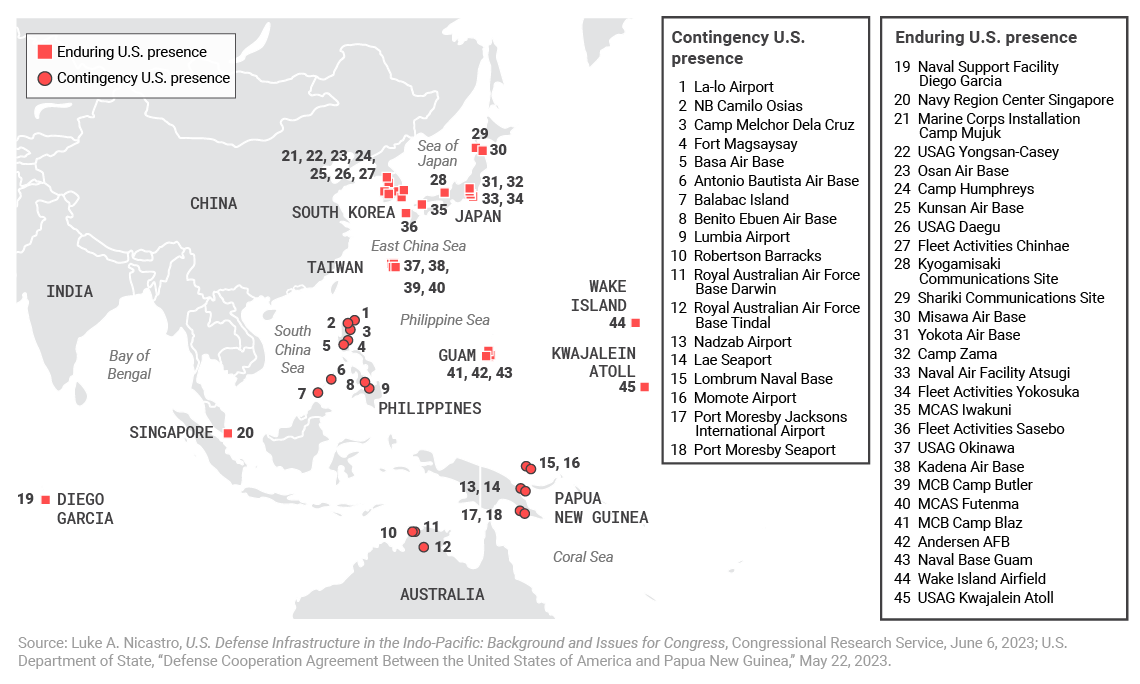
The United States has a robust network of bases across Asia. The squares show the locations of permanent U.S. bases while the circles show bases where U.S. forces rotate out of. Naval Communications Station Harold E. Holt is not depicted due to space constraints.
Although most plausible wars in East Asia would likely occur under vastly different circumstances, Ukraine’s experience of resisting Russian aggression provides several lessons for China’s neighbors on how to slow, stop, and reverse full-scale invasions.27David Barno and Nora Bensahel, “The Other Big Lessons that the U.S. Army Should Learn from Ukraine,” War on the Rocks, June 27, 2022, https://warontherocks.com/2022/06/the-other-big-lessons-that-the-u-s-army-should-learn-from-ukraine/. To deter China, they would do well to invest in air defense systems—survivable radar, missile batteries, and man-portable surface-to-air missiles—that would deny China air superiority in the event of a war. They ought to stockpile large quantities of weapons that can be used to defend against mechanized assaults, including antitank missiles (e.g., Javelins), drones, and loitering munitions (“suicide drones”). Island nations such as Japan, Taiwan, and the Philippines ought to continue to develop and invest in anti-ship missiles and unmanned naval drones, which can be used for intelligence purposes and are already being pursued by the U.S. Navy to help bolster available firepower.28Gabriel Honrada, “US, Japan, Taiwan To Share Real-time Drone Intel: Report,” Asia Times, June 10, 2023, https://asiatimes.com/2023/06/us-japan-taiwan-to-share-real-time-drone-intel-report/; David Sharp, “Navy Expedites Waterborne Drones to Close Gap with China,” Associated Press, June 29, 2022, https://apnews.com/article/technology-china-robotics-pacific-ocean-b8262b737593a07ca28d8b99b0f2555d. The wealthiest nations in the region should develop satellite systems along the lines of the private Starlink system, which could prove critical for controlling unmanned weapons systems in the event of war. And all regional powers should prioritize military training and other measures to ensure that, if war happens, a vast number of fighting-age men will be willing and able to serve.29The necessity for modern armies to combine mass conscription with “fighting spirit” is discussed in Anatol Lieven, “Ukraine’s Paradoxical Lessons for the Future of Warfare,” Responsible Statecraft, June 14, 2023, https://responsiblestatecraft.org/2023/06/14/ukraines-paradoxical-lessons-for-the-future-of-warfare/. See also Gil Barndollar, “Taiwan’s Military Service Extension Is Just a First Step,” Nikkei Asia, January 6, 2023, https://asia.nikkei.com/Opinion/Taiwan-s-military-service-extension-is-just-a-first-step.
In the context of offshore balancing, the United States would encourage East Asian militaries to capitalize on their geographic and technological advantages as defenders. For example, several of China’s neighbors are separated from the Chinese mainland by large expanses of water—namely, Taiwan, South Korea, Japan, and the Philippines—while others are divided from China by high mountains (Afghanistan, Bhutan, and Nepal), vast deserts (Mongolia), and dense forests (Myanmar, Laos, and Vietnam). Of all its neighbors, only Vietnam is tightly connected to China via road.
These geographic features mean that the prospects of deterring armed aggression in East Asia are good. Maritime states in particular should invest in naval mines, antiship missiles, naval drones, and other weapons meant to multiply the “stopping power of water.”30John J. Mearsheimer, The Tragedy of Great Power Politics (New York, NY: W.W. Norton, 2001), 83–137. The others should procure weapons systems and develop military doctrines designed to leverage their own geographic features, all with a view to convincing Chinese strategists that the costs of an armed attack against a neighboring state would far outweigh any benefits that might result from conquest.
GDP, military spending, and population size of China vs. Asian states (2022)
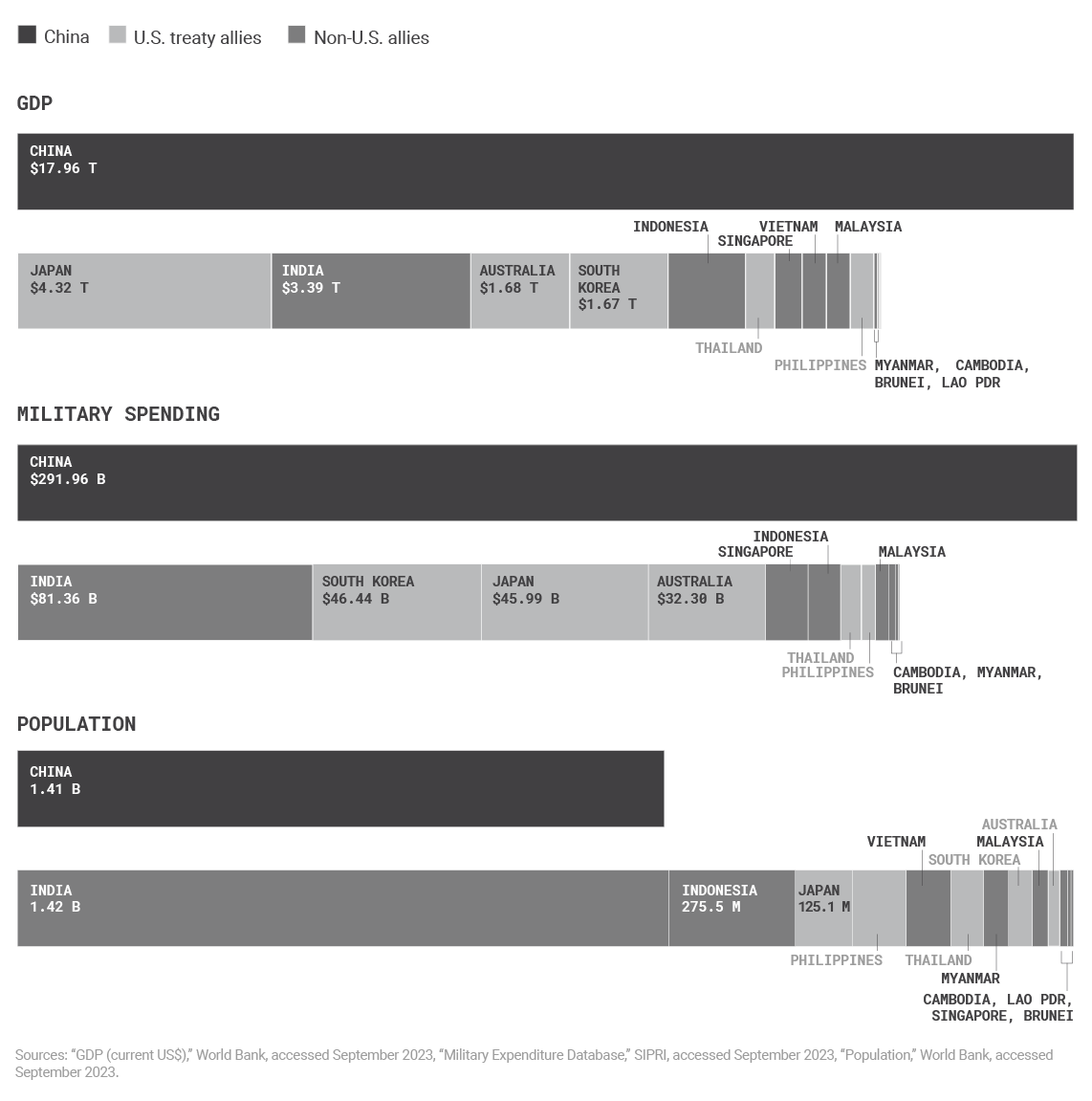
China is not surrounded by weak states, and many of its neighbors would be capable of resisting attempts by Beijing to subjugate them. Powerful states, like India and Japan, can balance China’s economic and military strength.
There would also be a strong political benefit to offshore balancing. Military deterrence is not the only way—nor even always the best way—to ensure international stability and uphold the territorial status quo. Sometimes diplomacy and political reassurances are required to reduce tensions and create the foundations for peaceful relations. This is especially the case with Taiwan, but it also applies to territorial disputes in the South China Sea, East China Sea, and Himalayas.31Thomas Christensen, “The Contemporary Security Dilemma: Deterring a Taiwan Conflict,” Washington Quarterly 25, no. 4 (2002): 5–21; Zuo Xiying, “Unbalanced Deterrence: Coercive Threat, Reassurance and the US-China Rivalry in Taiwan Strait,” Pacific Review 34, no. 4 (2021): 547–576.
Becoming an offshore balancer in East Asia would not result in the United States withdrawing its military forces from the region overnight. Instead, drawdowns would occur in conjunction with steps meant to make regional powers more capable of deterring Chinese aggression and resisting coercion on their own. The exact pace of this dual-track process would be determined by political leaders who are mindful of local conditions. It would be unwise to set arbitrary benchmarks that must be met before the United States would agree to withdraw.
That said, Washington should have confidence that, once a strategy of offshore balancing has been set in motion, regional powers will have strong incentives to begin preparing for their own defense in earnest. The order of operations must begin with the United States announcing and initiating military drawdowns—beginning with ground forces, even as U.S. naval and air bases are maintained for the foreseeable future—rather than waiting for allied powers to become self-sufficient, which may never happen without a clear U.S. commitment to retrench.
Offshore balancing, even when fully implemented, would not end U.S. economic and diplomatic engagement in East Asia. It is not synonymous with abandoning alliances, let alone isolationism.32Eugene Gholz, Daryl G. Press, and Harvey M. Sapolsky, “Come Home, America: The Strategy of Restraint in the Face of Temptation,” International Security 21, no. 4 (1997): 5–48, at 5–6. In fact, a strategy of offshore balancing might even make the United States more effective at working with regional powers on matters of mutual concern, including economic cooperation, climate change, and human rights. China especially would have fewer reasons to recoil from collaborations with the United States if Washington could credibly demonstrate a commitment to easing tensions in the security realm.33Yun Sun, “Why China Won’t Talk with America’s Military: Beijing Sees Silence as Leverage,” Foreign Affairs, July 21, 2023, https://www.foreignaffairs.com/united-states/why-china-wont-talk-americas-military.
What is the ultimate goal of offshore balancing? Ideally, it aims for the United States to be able to withdraw most or all of its military forces from East Asia. Of course, it is likely that the United States will always maintain an appropriate military presence in U.S. territories such as Guam, the Northern Mariana Islands, and its other Pacific Island territories for purposes of national self-defense. Existing formal alliances can also be retained. But over time, the long-term garrisoning of allied nations such as Japan and South Korea could and should come to an end as these states become more able to defend their own sovereignty and territorial integrity.
In sum, offshore balancing is a strategy of turning over responsibility for maintaining regional security to the region itself. It is a hard-headed approach that recognizes both the challenges posed by China’s rise and the opportunities for regional powers to deter unprovoked aggression without disproportionately relying upon the U.S. security umbrella. Fully implementing offshore balancing does not need to be done quickly; it is a long-term strategy for recalibrating America’s defensive posture in a way that leverages the considerable latent power that belongs to Washington’s allies and partners, as well as other regional states. But it can begin soon, and it should be recognized as the best overarching framework within which to secure U.S. interests while not exposing Americans to undue costs and risks.
China can’t easily expand
Despite the attractiveness of offshore balancing as a strategy, prominent scholars and U.S. officials continue to argue for U.S. primacy in East Asia.34See, for example, Hal Brands, “Fools Rush Out? The Flawed Logic of Offshore Balancing,” Washington Quarterly 38, no. 2 (2015): 7–28. Why? The answer has little to do with core U.S. interests, given that the United States has nothing to gain from the domination of the Western Pacific as an end in itself. Rather, arguments for U.S. primacy in the Western Pacific are based upon two assumptions about future regional trends: (1) China is planning to establish political and economic control over neighboring states, and might even intend to conquer them; and (2) regional powers would be incapable of resisting Chinese domination without U.S. forward deployments. Upon close inspection, however, neither of these assumptions is sound.
First, there is no clear-cut reason to conclude that China’s leaders have set their sights on dominating East Asia in military and economic terms—or that they could achieve regional dominance even if they sought it. While it is common for Western analysts to accuse Beijing of harboring such ambitions as they point at China’s increased military capabilities, these claims about Chinese intentions are unfalsifiable assertions.35John Pomfret and Matt Pottinger, “Xi Jinping Says He Is Preparing for War: The World Should Take Him Seriously,” Foreign Affairs, March 29, 2023, https://www.foreignaffairs.com/united-states/xi-jinping-says-he-preparing-china-war. To be sure, it is possible that President Xi Jinping or one of his successors might launch an imperialistic bid for regional dominance. But it is also plausible that Beijing will continue to be preoccupied with domestic development to the exclusion of military adventurism.36Indeed, Taylor Fravel has shown that Chinese leaders have often preferred to settle their territorial disputes via negotiated settlements. See his Strong Borders, Secure Nation: Cooperation and Conflict in China’s Territorial Disputes (Princeton, NJ: Princeton University Press, 2008). China has not initiated a war since 1979. While not evidence of current or future intentions, this does suggest that Beijing can be deterred or otherwise dissuaded from attempting an invasion; it is not a regime that thrives on war or has needed to fight wars to ensure political survival at home. Beyond Taiwan, there is little if any indication that China wants to conquer any country. Outsiders cannot know for sure what motivates China’s leaders now, or what will motivate them in the future.
It might be argued that U.S. strategists should prepare for the worst-case scenario—that Beijing is bent on regional domination—because ambition tends to grow with capability and the cost of underestimating China’s ambition might be worse than overestimating it. This is a defensible point. But as Jessica Chen Weiss has argued, there is also a danger that alarmism about China’s rise—especially when it comes to Taiwan—will become a “self-fulfilling prophecy.”37Jessica Chen Weiss, “Don’t Panic About Taiwan: Alarm Over a Chinese Invasion Could Become a Self-Fulfilling Prophecy,” Foreign Affairs, March 21, 2023, https://www.foreignaffairs.com/china/taiwan-chinese-invasion-dont-panic. Stephen Walt concurs, arguing that the threat of an all-out Chinese bid for hegemony in East Asia will remain low unless U.S. policymakers provoke such a bid through ill-advised primacist policies of their own.38Walt, “Stop Worrying About Chinese Hegemony in Asia.” These warnings ought to be taken seriously, lest U.S. leaders help to bring about the very outcomes that they want to avoid.
Second, even if Beijing is assumed to be a maximally revisionist power, it does not follow that China therefore constitutes an existential threat to the political independence or territorial integrity of its neighbors, still less the national security of the United States. As discussed above, the states of East Asia have a profound interest in maintaining their own sovereignty and are generally well-positioned to do so. They can be counted upon to resist Chinese expansionism through deterrence and, if necessary, wars of national survival—especially if the United States provides support. The bottom line is that even an inveterately hostile China would not necessarily pose a security threat to East Asia or the United States. It could be deterred.
Consider what an expansionist Chinese leader would be up against. On land, China is bordered by 14 states. Of these, four are nuclear-armed powers (Pakistan, India, Russia, and North Korea) and three are members of the Russia-led Collective Security Treaty Organization (Kazakhstan, Kyrgyzstan, and Tajikistan). As noted above, the others are separated from China by deserts, high mountains, and dense forests. Some are poor, sparsely populated, and of little obvious economic value to a prospective invader. None fit the description of a potential target that is both desirable and easily conquerable.
China shares maritime borders with at least two countries: Japan and the Philippines. If China’s ten-dash line is taken seriously, then Beijing considers itself to also have maritime borders with Brunei and Malaysia in the South China Sea. It is reasonable to conclude that China poses more of a threat to its maritime neighbors than adjoining states on the mainland. The prospect of a Chinese annexation of the Senkaku/Diaoyu Islands or a maritime clash in the South China Sea seems to be much more plausible than a Chinese invasion of Mongolia or Vietnam. Taiwan, of course, represents a special case, with a Chinese armed attack on Taiwan routinely discussed in the media, among analysts, and in official circles. But even so, China’s capacity to wage a sustained naval campaign against its neighbors—let alone in the open Pacific—is significantly limited and ought not to be exaggerated.39Mike Sweeney, “Assessing Chinese Maritime Power,” Defense Priorities, October 26, 2020, https://www.defensepriorities.org/explainers/assessing-chinese-maritime-power.
Of course, if China was dedicated to invading one of its neighbors, the PLA could be mobilized toward this end. Water can be crossed, mountains traversed, and forests penetrated. But such geographic obstacles would still make a sustained military operation difficult to accomplish at an acceptable cost, especially if China’s neighbors can maximize their geographic advantages by investing in the right kinds of defensive technologies and military tactics (resilient and portable air-defense systems, antitank missiles, drones, loitering munitions, naval mines, coastal defense missile systems, etc.).
It is difficult to imagine that a Chinese bid for regional domination could take place without inciting other regional states to form a balancing coalition. Is it plausible that great powers such as Russia (still a nuclear-armed power despite its disastrous war in Ukraine), India (now the world’s most populous state), and Japan would tolerate China establishing military, political, or economic control over East Asia? Russia has a historic interest in maintaining geopolitical influence in Central Asia; India has a national interest in staving off Chinese expansionism in the Himalayas, South Asia, and the Indian Ocean; and Japan would surely respond vigorously in the event of a Chinese attack on East Asia’s maritime states. Even smaller states such as Vietnam have military histories that would give PLA leaders pause.
The argument is not that regional powers would automatically join together to resist Chinese expansionism at the first sign of aggression. For one thing, there are historical antagonisms that plague relations between, say, Japan and South Korea, and India and Pakistan. It strains credulity to imagine that Russia or North Korea could be folded into a pan-Asian coalition against China. And only a handful of Indo-Pacific states—all small island nations—recognize Taiwan as a sovereign entity, which limits (but does not rule out) the prospect of Taipei being fully included in collective defense efforts. Nevertheless, if the scale of Chinese aggression ever rose to the level of a bid for regional dominance, it is fanciful to expect that regional powers would remain passive. At the very least, Chinese leaders can recognize that any act of unprovoked aggression in East Asia would run the risk of them becoming bogged down in difficult wars of conquest and provoking balancing behavior along its periphery, both “internal” and (depending on the circumstances and severity of the threat) “external.”40Internal balancing is when states use their own national resources to deter a potential aggressor. External balancing is when states join together into formal or informal alliances. Internal balancing is already happening in East Asia, but external balancing is unlikely to happen in the short or medium term without U.S. participation in balancing coalitions. Long term, the opportunity exists for regional states to form collective security pacts that do not require the participation of the United States, or which require only limited support from Washington.
U.S. Asian allies’ military spending (2012—2022)
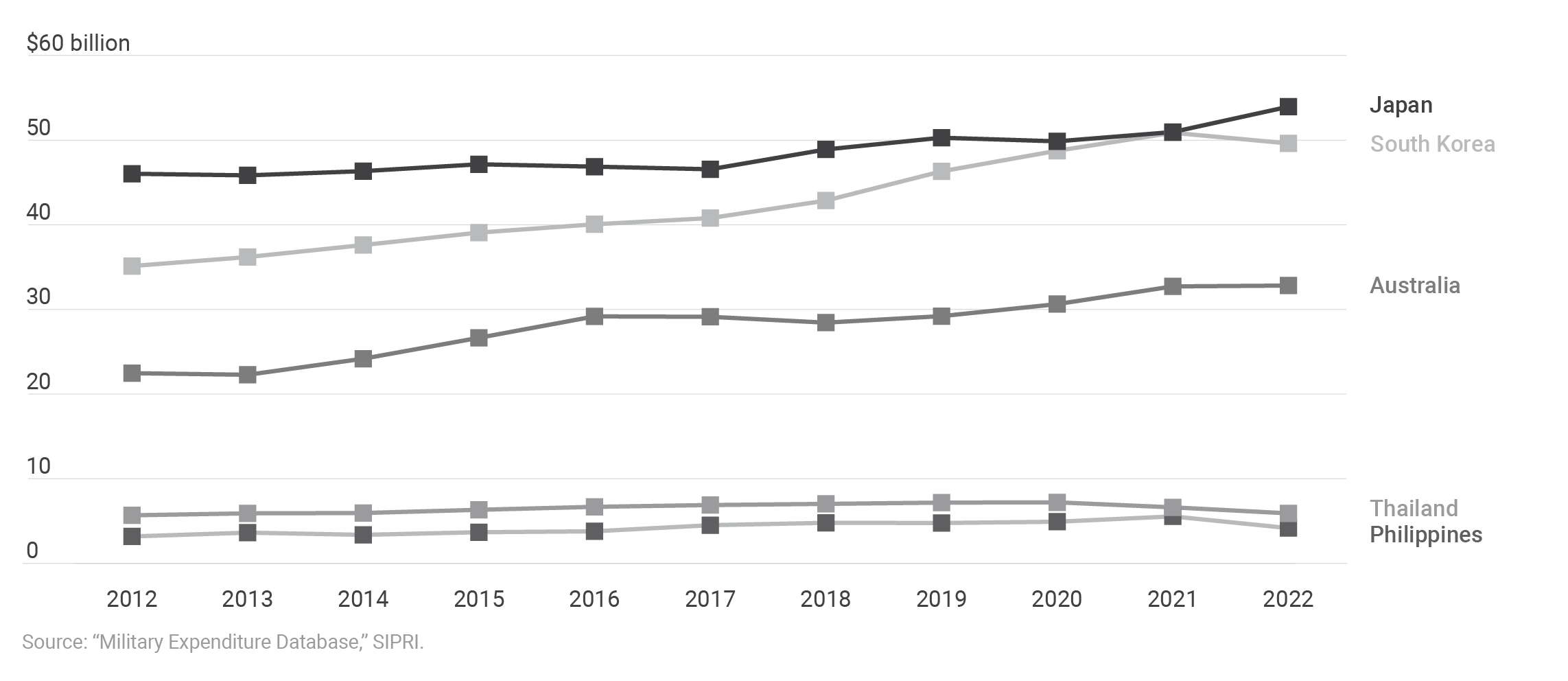
Measured in billions of constant 2021 U.S. dollars, Japan has boosted its military expenditures the most since 2012 along with Australia. Meanwhile, South Korean military expenditures have stagnated in recent years while Thai and Filipino expenditures have stayed flat despite rising U.S.-China tensions.
None of this means that the United States or its allies should be complacent. It is important that policies are put in place to raise the expected costs of Chinese expansionism in order to deter war. But it does mean that U.S. leaders can afford to shift the burden of containing China’s rise onto regional allies and partners. This work should begin with frank conversations—held in private at first—about the limits of U.S. willingness to fight a war in East Asia, the plan to shift to a more off-shore posture, and pointed reminders that regional powers have the indigenous capacity to threaten Beijing with massive repercussions.
There are already signs that some regional powers such as the Philippines, Australia, Taiwan, and Japan are moving to augment their militaries in response to perceived aggression by Beijing.41Jon Grevatt and Andrew MacDonald, “Philippines Proposes 8% Increase in Defence Budget,” Janes, August 23, 2022, https://www.janes.com/defence-news/news-detail/philippines-proposes-8-increase-in-defence-budget; Julian Kerr and Andrew MacDonald, “Australia Proposes Defence Spending Boost for 2023,” Janes, October 26, 2022, https://www.janes.com/defence-news/news-detail/australia-proposes-defence-spending-boost-for-2023; Yimou Lee and Ben Blanchard, “Taiwan Aims for Big Rise in Defence Spending Amid Escalating China Tension,” Reuters, August 25, 2022, https://www.reuters.com/business/aerospace-defense/taiwan-proposes-129-on-year-rise-defence-spending-2023-2022-08-25/; Xiao Liang and Nan Tian, “The Proposed Hike in Japan’s Military Expenditure,” Stockholm International Peace Research Institute, February 2, 2023, https://www.sipri.org/commentary/topical-backgrounder/2023/proposed-hike-japans-military-expenditure. This is an encouraging development in the sense that it shows the capacity of regional governments to respond to changes in their geopolitical circumstances. But most analysts agree that East Asian states can still do much more to deter potential Chinese aggression and improve their resilience. Taiwan, for example, still only spends around 2.4 percent of its GDP on defense—this despite major hikes to defense outlays.42Keoni Everington, “Taiwan Increases Defense Budget by 13.9% for 2023, Rising to 2.4% of GDP,” Taiwan News, August 25, 2022, https://www.taiwannews.com.tw/en/news/4637283. Japan, too, has been slow to move beyond spending more than 1 percent of its GDP on its military. Even Tokyo’s most ambitious plans envisage just 2 percent of its GDP being spent on defense.43See Adam P. Liff, “No, Japan Is Not Planning to “Double its Defense Budget,” Brookings Institution, May 22, 2023, https://www.brookings.edu/articles/no-japan-is-not-planning-to-double-its-defense-budget/.
Not only are these funds insufficient, but they are also often spent on the wrong weapons. Taiwan is the most obvious case in point, with analysts accusing Taipei of wasting money on “prestige” items that would likely be destroyed early on in a war with China—such as diesel submarines, stealth aircraft, helicopter carriers, and F-16 fighter jets—instead of investing in “a resilient, survivable force with the ability to asymmetrically counter-attack.”44Colin Carroll and Rebecca Friedman Lissner, “Forget the Subs: What Taipei Can Learn from Tehran About Asymmetric Defense,” War on the Rocks, April 6, 2017, https://warontherocks.com/2017/04/forget-the-subs-what-taipei-can-learn-from-tehran-about-asymmetric-defense/. See also Paul Huang, “Taiwan’s Military Is a Hollow Shell,” Foreign Policy, February 15, 2020, https://foreignpolicy.com/2020/02/15/china-threat-invasion-conscription-taiwans-military-is-a-hollow-shell; Paul Huang, “Threats to Taiwan’s Security from China’s Military Modernization,” in Meeting China’s Military Challenge: Collective Responses of U.S. Allies and Security Partners (NBR Special Report no. 96), ed. Bates Gill (Washington, DC: National Bureau of Asian Research, 2022), 25–35, https://www.nbr.org/publication/meeting-chinas-military-challenge-collective-responses-of-u-s-allies-and-partners/.
Reorienting the states of the Western Pacific toward the collaborative endeavor of maintaining regional security will take time, but it is well within the realm of possibility, and ought to rank high on America’s lists of foreign-policy priorities. A strategy of offshore balancing is the best means of unlocking the region’s defensive potential.
Strategic retrenchment is preferable to primacy
So far, it has been argued that regional powers in East Asia are capable of balancing a rising China even if Beijing begins to display more aggressive and expansionist tendencies. The implication is that the United States could afford to shift the burden of upholding international security onto regional partners. But “could” is not the same as “should.” What is the self-interested case for retrenchment in East Asia?
There are at least four reasons why the United States ought to pursue retrenchment in the Western Pacific. First and foremost, the United States has a clear interest in reducing the likelihood of being dragged into an East Asian war started at a time of an adversary’s choosing. This is a serious concern. For while some in the United States might believe that Washington could limit its military reaction in the event of a North Korean attack on South Korea or a Chinese attack on Taiwan, it is possible that an adversary might choose to preemptively attack forward-deployed U.S. forces instead of waiting for a response from leaders in Washington. If this happened, the United States would find itself engaged in an East Asian war against its will. Retrenchment from East Asia would lower the risk of such preemptive assaults by reducing the number of U.S. troops exposed to foreign attack.
It is often forgotten that U.S. extended deterrence—in East Asia and elsewhere—is based in part upon the logic of what Thomas Schelling called “the threat that leaves something to chance.”45Thomas C. Schelling, The Strategy of Conflict (Harvard, MA: Harvard University Press, 1960). Schelling grasped that the threat of fighting on behalf of a client state is always difficult to make credible. This is especially true when threatening to use nuclear weapons against a similarly nuclear-armed adversary. The threat to initiate a cataclysmic nuclear war is simply not a threat that an adversary can be made to readily believe.
By putting troops in harm’s way, the United States overcomes these credible commitment problems by convincing its adversaries that a military escalation (including the use of nuclear weapons) might happen in response to U.S. military personnel being killed in an unprovoked attack, not because a U.S. leader would necessarily want to authorize such an escalation, but because political leaders would lose a degree of control over the situation. In other words, one of the purposes of forward-deployed garrisons (“trip wires”) is to ensure that nobody can be confident about what would happen in the event of an attack on a U.S. ally.
Offshore balancers argue that such risks are not worth taking when judged against U.S. national interests—and, in any case, are unnecessary given that regional allies are now more than capable of issuing their own (inherently credible) military threats against would-be attackers. This might not have been the case in the early Cold War period when these alliances were formed, but it is true today.
This leads to the second self-interested reason why the United States ought to retrench from East Asia: despite the myth of U.S. omnipotence, regional powers—not America—are the ones best placed to deter China from engaging in wars of aggression. Viewed in this light, offshore balancing is the best means that the United States has for achieving its chief policy priority of avoiding a major war in East Asia. The logic here is that the effectiveness of any deterrent depends upon the deterrer’s capabilities and resolve. While the United States has the most powerful military in the world, its commitment to fight a nuclear-armed China will always suffer from credibility problems. East Asian states, on the other hand, can credibly pledge to fight China in defense of their own territorial integrity and other core national interests. It is these threats—ones that China will actually believe—that must form the basis of deterrence in East Asia.46China’s nuclear arsenal plays a key role here. In the event China attacks Taiwan or a neighboring state, the threat of nuclear escalation would weigh heavily on the minds of U.S. leaders. It is possible, if not highly likely, Washington would decide to stay out of a war with China for fear of the conflict “going nuclear.” This is precisely what has happened with Russia’s invasion of Ukraine. But just as Ukraine has fought back against Russia, China’s nuclear status would do nothing to prevent a state or territory from fighting back against a Chinese invading force.
Third, U.S. strategic retrenchment will signal to Beijing and other regional powers that the United States is not interested in securing dominance in East Asia or plunging the region into a new cold war. The alternative—to increase U.S. deployments in step with China’s rise in power—would signal the opposite, that Washington is (or might be) committed to maintaining military supremacy in East Asia. In turn, this would worsen relations with China, contribute to a dangerous arms race in the Indo-Pacific, and confirm regional powers’ worst fears (discussed in more detail below) about an impending superpower rivalry that will leave all parties worse off.47It is worth emphasizing that U.S. balancing behavior against China is uniquely prone to causing a security dilemma and provoking an arms race because of America’s inherent difficulty proving its actions are motivated by self-defense, a problem that regional powers do not have.
U.S. forces permanently stationed in Asia
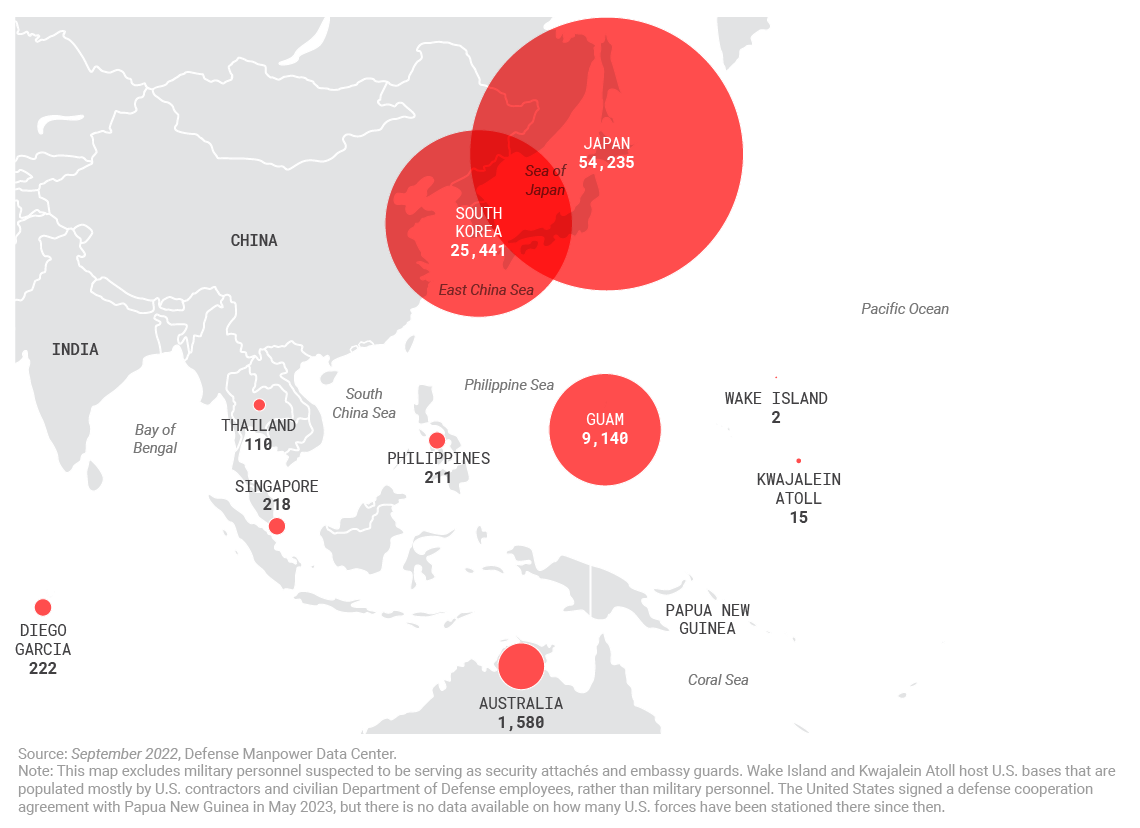
The United States has more than 90,000 active-duty and reserve forces permanently stationed across Asia. The presence of U.S. forces disincentivizes allies from doing more to bolster their defenses and balance against China.
One crucial distinction to make is that China is unlikely to view investments in defense weapons by local powers in the same way as it interprets U.S. military investments. Regional powers can undertake the work of militarily balancing against China—and deterring potential wars of aggression—without running the same risk of triggering a security dilemma with China.48Gholz, Friedman, and Gjoza, “Defensive Defense,” 173. In contrast, U.S. efforts to enlarge its military footprint in East Asia are invariably interpreted by Beijing as being of a potentially hostile nature. It therefore makes more strategic sense for local actors to shoulder more of the burden of deterring China through defensive military means.
Fourth, cutting the cost of U.S. deployments in the Indo-Pacific would save taxpayers trillions of dollars over the coming decades. This is always an important consideration, but especially so in the context of a ballooning national debt and concerns over the solvency of U.S. grand strategy. According to some estimates, U.S. Indo-Pacific Command will require upwards of $21 billion per year by 2025 (in contrast to the $11 billion authorized in 2022) to meet all of the expectations being placed upon it by political leaders in Washington. This “surge” in spending is “driven by long-range naval weapons, construction of new bases and periodic waypoints for U.S. troops, and new air and missile defense sensors.”49Jack Desch, “Biden Budget Expected to Stiff the Indo-Pacific,” Foreign Policy, March 9, 2023, https://foreignpolicy.com/2023/03/09/us-military-china-taiwan-pentagon/. Globally, America’s overseas military bases are estimated to cost the United States around $55 billion per year.50Jonathan Stevenson, “Overseas Bases and U.S. Strategy: Optimising America’s Military Footprint,” International Institute of Strategic Studies, Adelphi Series No. 484–486 (London, UK: IISS, 2020), 9. Cutting the size of these bases—especially those hosting large numbers of ground forces—would lead to considerable savings, especially if force structure and administrative support costs are cut as a result.
For these reasons, the United States should begin to work alongside its regional allies and partners to ensure that they have credible options for deterring Chinese aggression beyond simply relying on the U.S. security umbrella. Washington does not need to abandon its friends in East Asia, nor does it need to move to an offshore balancing posture in a hasty fashion. But the move toward retrenchment and offshore balancing makes strategic sense from the perspectives of the United States, regional powers, and the wider international order.
Avoiding a U.S.-China cold war
East Asian powers can deter Chinese expansionism and, if necessary, resist China militarily. This should reassure all sides that a Chinese bid for hegemony in East Asia is not in the cards. At the same time, it is important to note that the leaders of some prominent states in East Asia have expressed hope that a “cold war” with China can be avoided. This point is often missed by U.S.-based analysts.51For a notable exception, see Kelly A. Grieco and Jennifer Kavanagh, “The Indo-Pacific Has Already Chosen Door No. 3,” Foreign Policy, May 31, 2023, https://foreignpolicy.com/2023/05/31/us-china-indo-pacific-asia-biden-diplomacy-competition/.
Small and middle powers have been especially vocal in their opposition to a new cold war. Members of the Association of Southeast Asian Nations (ASEAN), for example, have insisted that the region’s great powers should not force small states to pick sides. ASEAN is committed to the ideas that Southeast Asia should remain “central” to Indo-Pacific geopolitics, that great powers such as China and the United States must participate in multilateral forums where smaller powers have a large amount of say, and that the region should be defined by positive-sum interactions, especially in the economic sphere. As one high-ranking Singaporean official has said, “No one wants to be in a position where we have to either contain China’s rise or limit America’s presence … Any move in either direction will have few takers in the region because no one in ASEAN wants to see a new Cold War.”52David Rising, “Australian PM Albanese Stresses Need for Diplomacy, Guardrails in Dealing with China,” Associated Press, June 2, 2023, https://apnews.com/article/asia-pacific-security-forum-shangrila-singapore-07f69ba74958e192020e1daf55bb2440.
Even India and Japan—two members of the U.S.-aligned Quad, and each a reliable counterweight to Chinese power in Asia—have expressed misgivings about the division of Asia into two armed camps. Even deadly border clashes between Indian and Chinese troops were not enough to prevent Indian Prime Minister Narendra Modi from calling for “peace and tranquility” with China, as well as the “normalization” of bilateral ties.53Y.P. Rajesh, “Indian PM Modi Says Peace on Border Essential for Normal Ties with China,” Reuters, May 19, 2023, https://www.reuters.com/world/india/india-pm-says-peace-border-essential-normal-ties-with-china-2023-05-19/. Japan, meanwhile, has strong economic ties with China, which few Japanese want to lose.54Yoshiaki Nohara, “For Millions of Japanese, Confrontation Between the U.S. and China Is Already a Reality,” Bloomberg, May 9, 2022, https://www.bloomberg.com/features/2022-us-china-cold-war-risk-rattles-japan/; Ken Moriyasu, “‘China-led order won’t materialize’: Japan experts call for realism,” Nikkei Asia, July 25, 2023, https://asia.nikkei.com/Politics/International-relations/Indo-Pacific/China-led-order-won-t-materialize-Japan-experts-call-for-realism. While New Delhi and Tokyo are certainly interested in blunting China’s military influence, they each have strong incentives to maintain close ties with Beijing with a view to averting war through political means.
Nor should it be forgotten that in 2007 Australia quit the first iteration of the Quad because of a fear that continued participation would needlessly antagonize China and jeopardize the Sino-Australian economic relationship. Though Canberra subsequently returned to the Quad, the current Australian Prime Minister, Anthony Albanese, has made it clear that “Australia’s goal is not to prepare for war, but to prevent it through deterrence and reassurance and building resilience in the region, doing our part to fulfill the shared responsibility all of us have to preserve peace and security.” He has also said: “This isn’t about a policy of containment. It’s not a question of placing obstacles in the way of any nation’s progress or their potential.”55Gabriel Dominguez, “Australia’s Albanese Calls for ‘Guardrails’ and ‘Dialogue’ to Prevent U.S.-China Conflict,” Japan Times, June 3, 2023, https://www.japantimes.co.jp/news/2023/06/03/asia-pacific/politics-diplomacy-asia-pacific/albanese-shangrila-dialogue-keynote-speech/.
Even a cursory analysis of East Asian leaders’ statements on China reveals that, for the most part, regional powers do not (yet) view China as a threat to their national survival. At the very least, East Asian states seem to be less concerned about the security implications of China’s rise than alarmists in the United States. This helps to explain why China’s neighbors thus far have done less than the maximum to balance against China. Even Japan, which has announced some major increases to its defense budget in recent years, still evinces a desire for stable, constructive, and less confrontational relations with China.56Christopher B. Johnstone, “Kishida Meets Xi Jinping,” Center for Strategic and International Studies, November 15, 2022, https://www.csis.org/analysis/kishida-meets-xi-jinping.
ASEAN and U.S. allies trade volume with China (2000–2021)
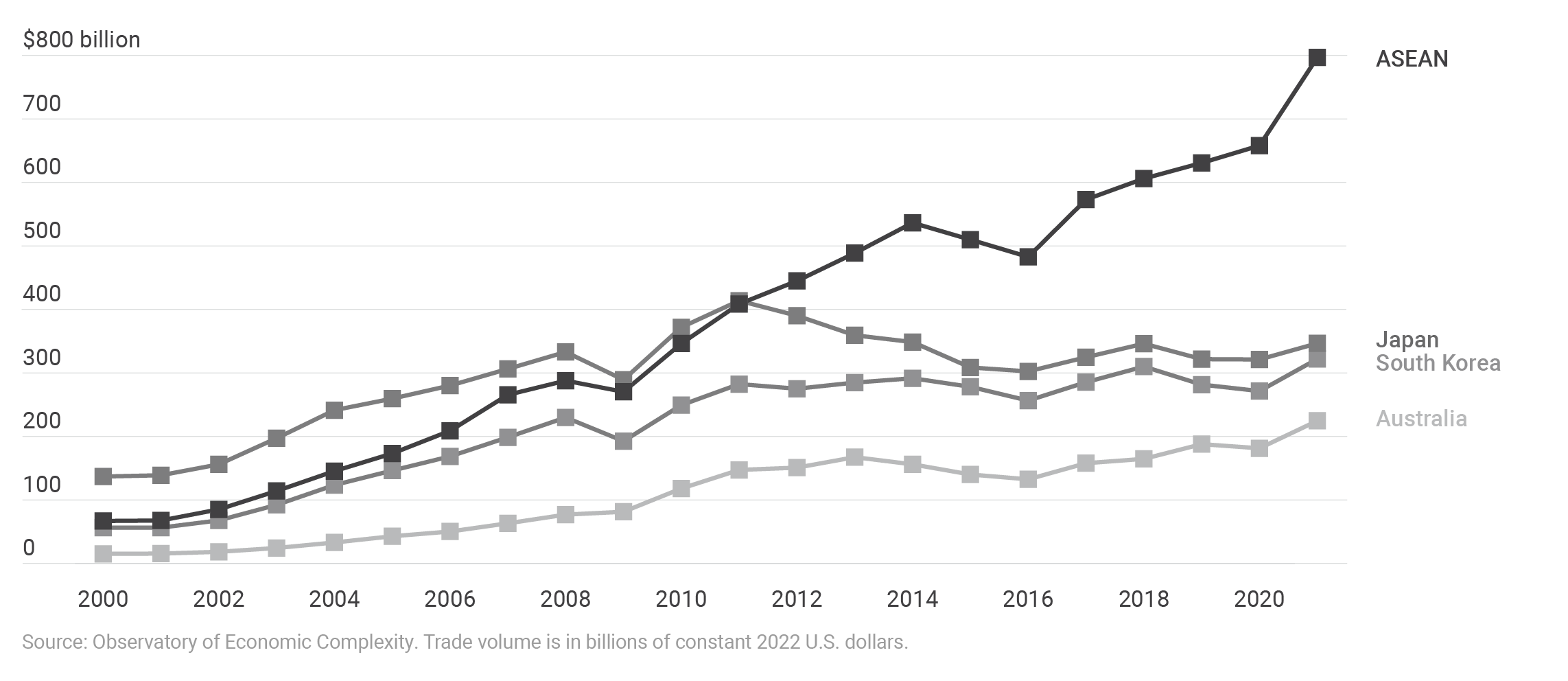
While many countries in Asia have grown wary of Beijing’s intentions in recent years, that has not stopped them from continuing to trade with China. Annual trade volume with ASEAN (Brunei, Myanmar, Cambodia, Indonesia, Laos, Malaysia, the Philippines, Singapore, Thailand, and Vietnam) will soon exceed $800 billion while Australia, Japan, and South Korea increased their exports to and imports from China since 2000.
At the same time, several East Asian states, including U.S. treaty allies such as South Korea and partners such as Thailand, continue to “hedge” in terms of their foreign relations, seeking friendly ties with both Beijing and Washington.57Min-hyung Kim, “Hedging Between the United States and China? South Korea’s Ideology-Driven Behavior and Its Implications for National Security,” International Relations of the Asia-Pacific 23, no. 1 (2023): 129–158; Mark S. Cogan, “Is Thailand Accommodating China?” Southeast Asian Social Science Review 4, no. 2 (2019): 24–47. See also Alfred Gerstl, Hedging Strategies in Southeast Asia: ASEAN, Malaysia, the Philippines, and Vietnam and Their Relations with China (New York, NY: Routledge, 2022). While it is possible that these states are pursuing sub-optimal security policies—in other words, “under-balancing”—it might also be the case that they are more accurately reading the threat posed by China than observers in the United States.
There are several implications for U.S. foreign policy. First, Washington should not insist that regional powers choose sides in its rivalry with China. Because several of these states are already pursuing hedging strategies, a heavy-handed approach from Washington might push regional powers into the arms of Beijing or at least cause states to keep the United States at arm’s length. Second, U.S. leaders should be unabashed about pursuing a cooperative relationship of their own with China. This is precisely what the region wants; would serve America’s political, economic, and security interests; and is the best way of telegraphing to the world that the United States is not interested in starting another conflict similar to the Cold War. After all, the United States and China renounced ambitions to “hegemony” in the 1970s per the text of the Shanghai Communique, a twin set of renunciations that should still form the basis of U.S.-China relations.58See “Joint Communique of the United States of America and the People’s Republic of China,” February 28, 1972, http://www.taiwandocuments.org/communique01.htm.
Third, the United States must impress upon regional powers that it is primarily their responsibility to provide for their own national defense. Washington should encourage regional powers to create their own appropriate blend of military balancing and cooperation with China. The understanding must be that U.S. foreign policy will assume that regional states have the interest and will develop the capabilities to deter Chinese aggression by themselves. Establishing this new modus vivendi will take time. But the process of downsizing America’s military footprint in Asia must be initiated by the United States or else it will never happen.
The Taiwan exception
The Taiwan issue is a sui generis challenge for the United States and its allies. For Taipei, any U.S. moves toward retrenchment and offshore balancing would likely be construed as a form of abandonment and an invitation for Beijing to attempt forced unification. These are important concerns which must not be dismissed. The United States has an interest in maintaining the political status quo across the Taiwan Strait and dissuading either side from trying to “resolve” the Taiwan issue using force.59Peter Harris, “Deterring a Chinese Invasion of Taiwan: Upholding the Status Quo,” Defense Priorities, May 16, 2022, https://www.defensepriorities.org/explainers/deterring-a-chinese-invasion-of-taiwan. However, it is possible for the United States to become an offshore balancer in East Asia without “abandoning” Taiwan to the People’s Republic of China.
First, it is important to emphasize that the United States does not presently guarantee the security of Taiwan. There is no security pact between Washington and Taipei. And while the Taiwan Relations Act commits the U.S. government to providing Taiwan with the means of its own defense and “maintain[ing] the capacity…to resist any resort to force or other forms of coercion that would jeopardize the security, or social or economic system, of the people on Taiwan,” the United States could fulfill these obligations while playing the role of offshore balancer. In other words, there is no reason why a shift toward offshore balancing should produce a substantive change in the status quo in terms of U.S.-Taiwan relations.
Second, it is possible—perhaps even likely—that a drawdown of U.S. forces in East Asia would reduce the likelihood of a Chinese attack on Taiwan. As other analysts have pointed out, the most likely cause of a Chinese invasion of Taiwan would be if leaders in Beijing concluded that a peaceful unification was being put out of reach.60See, for example, Council on Foreign Relations, “U.S.-Taiwan Relations in a New Era,” Independent Task Force Report No. 81, vii, 3, 29, 42–43, https://live-tfr-cdn.cfr.org/sites/default/files/2023-06/TFR81_U.S.-TaiwanRelationsNewEra_SinglePages_2023-06-05_Online.pdf. Vast deployments of U.S. troops to the Western Pacific, and explicit preparations by the United States for war over Taiwan, will only hasten Beijing to reach this conclusion.
The best way for Taiwan to ensure its own security is for the island to acquire autonomous capabilities to deter a Chinese armed attack. Relying on the United States to shoulder the burden of deterring China is the wrong approach.61As Joshua Rovner argues, U.S. strategic ambiguity is more of a statement of fact than a changeable policy; no matter what anyone in Washington might say now or in the future, Taiwan can never be sure that the United States will choose to enter a war with China on Taiwan’s behalf. See Josh Rovner, “Ambiguity Is a Fact, Not a Policy,” War on the Rocks, July 22, 2021, https://warontherocks.com/2021/07/ambiguity-is-a-fact-not-a-policy. As others have written, this would require Taipei to invest in large amounts of defensive weaponry that could be used to inflict terrible losses on a Chinese invasion force. The island of Taiwan should be turned into a “porcupine” that China would struggle to subdue, let alone incorporate.62Timbie and Ellis, “A Large Number of Small Things”; Jared M. McKinney and Peter Harris, “Broken Nest: Deterring China from Invading Taiwan,” Parameters 51, no. 4 (2021): 23–36. This will require much more defense spending and higher taxes than Taiwan currently asks of its population, as well as a sustained political campaign to prepare the Taiwanese public for the hardships of national defense. As Gil Barndollar has written, Taiwan must also lengthen and deepen the training of conscripts in the Taiwanese military.63Barndollar, “Taiwan’s Military Service Extension Is Just a First Step.” All of this is consistent with a U.S. policy of offshore balancing.
To be sure, Taiwan might have difficulty building a military force sufficient to threaten Beijing with an outright defeat in the event of war. China is too big—and Taiwan is too small—for Taiwan to become the superior military actor. But Taiwan can still threaten China’s leaders with enormous, and perhaps intolerable, costs if ever the Mainland attempts to invade and occupy Taiwan. If these costs can be made to seem severe enough—sunken ships, downed planes, dead military personnel, and a domestic economy in disarray—then Taiwan can still hope to dissuade China from attempting forcible unification, all without having to rely on Washington to fight on its behalf.
The bottom line is that the status quo across the Taiwan Strait can be maintained even in the context of a gradual U.S. strategic withdrawal from East Asia. If the United States becomes an offshore balancer in the Western Pacific, Taiwan will still have access to U.S. arms. Washington will still reserve the right—just as it does today—to intervene in a major East Asian war, should entering such a conflict be judged as being in the U.S. national interest. But Taiwan will have become more resilient to Chinese coercion, more credibly committed to maintaining the political status quo, and less dependent upon outside powers for its national defense.
Conclusions
Despite the scaremongering, East Asia today does not stand on the precipice of a World War III-type scenario. There is no major crisis in the Indo-Pacific that warrants a massive U.S. military buildup in the region. If China or some other hostile power ever looked poised to conquer the region and use its vast resources to menace the United States, then it would, of course, make strategic sense for Washington to mobilize for a defense of core East Asian allies and U.S. national interests.64Robert Kagan, “Challenging the U.S. Is a Historic Mistake,” Wall Street Journal, February 3, 2023, https://www.wsj.com/articles/challenging-the-u-s-is-a-historic-mistake-11675441152. At present, however, this scenario is far from a material reality. No invasion force is gathering to attack the United States from across the Pacific. East Asia is at peace. The challenge today is less dire and more manageable than the pessimists would suggest: It is to maintain a stable balance of power and an open economic system in the region.
In this context, calls for the United States to pursue military primacy in East Asia are wrong and dangerous. America’s interests in East Asia do depend upon a stable balance of power in the region, but they do not depend upon a U.S.-dominated region. Efforts to reestablish U.S. primacy are likely to backfire by provoking China, alienating nervous regional powers, and contributing to a self-fulfilling prophecy about the inevitability of U.S.-China conflict.
Instead, America’s interests in East Asia can best be served via a strategy of offshore balancing—that is, arming and supporting regional powers as they pursue their own self-interested defense policies. Offshore balancing is well suited to prevailing geopolitical conditions in East Asia because it acknowledges that the region is made up of strong, wealthy, and growing independent states, all of which have a direct stake in maintaining a stable balance of power and resisting the hegemonic ambitions of any hostile power, should such a power emerge in the future.
The Western Pacific is not America’s lake. But nor is it fertile ground for Chinese expansionism. It is a region well-situated to enjoy the fruits of stable international relations and economic cooperation. The United States should avoid implementing a wrongheaded strategy of military primacy, which might jeopardize the region’s future security and prosperity, and instead choose offshore balancing. In the final analysis, this is the best way for Washington to pursue its longstanding policy priorities while still respecting the rights, sovereignty, independence, and responsibilities of regional powers themselves.
Endnotes
- 1Michael Beckley and Hal Brands, Danger Zone: The Coming Conflict with China (New York, NY: W.W. Norton, 2022); Elbridge Colby, The Strategy of Denial: American Defense in an Age of Great Power Conflict (Yale, CT: Yale University Press). Cf. Joshua R. Itzkowitz Shifrinson, “Neo-Primacy and the Pitfalls of U.S. Strategy toward China,” Washington Quarterly 43, no. 4 (2020): 79–104.
- 2Daniel Drezner, “Military Primacy Doesn’t Pay (Nearly As Much As You Think),” International Security 38, no. 1 (2013): 52–79.
- 3Charles L. Glaser, “Washington Is Avoiding the Tough Questions on Taiwan and China,” Foreign Affairs, April 28, 2021, https://www.foreignaffairs.com/articles/asia/2021-04-28/washington-avoiding-tough-questions-taiwan-and-china.
- 4Brendan Taylor, The Four Flashpoints: How Asia Goes To War (Carlton, AU: LaTrobe University Press/Black Inc Books, 2018). On the differences between territorial and maritime sovereignty disputes, see Bec Strating, “Maritime and Sovereignty Disputes in the East China Sea,” Maritime Awareness Project, February 9, 2021, https://www.nbr.org/publication/maritime-and-sovereignty-disputes-in-the-east-china-sea/.
- 5While Taiwan is not a treaty ally of the United States, the U.S. military could become embroiled in a war over Taiwan if Chinese forces attacked U.S. positions in a preemptive attack or if a sitting U.S. president decided that joining the war was in the national interest, especially if facing political pressure in Washington and if given military advice that a war could be kept “limited” and “winnable.”
- 6Between May 2020 and January 2021 (and again in December 2022), Chinese and Indian forces engaged in direct combat along the Line of Actual Control that separates them in contested Himalayan regions. Twenty Indian and four Chinese soldiers were killed.
- 7There is an alternative view, however, that the costs of war to the U.S. economy could be modest. This argument is rooted in an expectation that the globalized world economy is quite resilient and the finding that neutral countries have not, historically, suffered massive economic costs as a result of third parties’ wars. See Eugene Gholz and Daryl G. Press, “The Effects of Wars on Neutral Countries: Why It Doesn’t Pay to Preserve the Peace,” Security Studies 10, no. 4 (2001): 1–57.
- 8China Power Project, “How Much Trade Transits the South China Sea?” Center for Strategic and International Studies, January 25, 2021, https://chinapower.csis.org/much-trade-transits-south-china-sea/.
- 9The point is not that goods bound to North America travel through the South China Sea. Obviously, most U.S. trade with East Asia traverses the Pacific Ocean. But the U.S. economy would nevertheless be affected by the global increases in prices that would occur as a result of war—an outcome previewed by the war in Ukraine, which resulted in major disruptions to grain exports from Ukraine and energy exports from Russia.
- 10Gerard DiPippo and Jude Blanchette, “Sunk Costs: The Difficulty of Using Sanctions to Deter China in a Taiwan Crisis,” Center for Strategic & International Studies, June 12, 2023, https://www.csis.org/analysis/sunk-costs-difficulty-using-sanctions-deter-china-taiwan-crisis.
- 11In Asia, the United States is also a treaty ally of Thailand and Australia. Neither state is currently involved in a territorial dispute, however. The relationship with Taiwan is particularly salient in U.S. domestic politics given that the Taiwan Relations Act legally defines “any effort to determine the future of Taiwan by other than peaceful means” as “of grave concern to the United States.” See Taiwan Relations Act, Pub. L No. 96–8 (1979), https://www.congress.gov/96/statute/STATUTE-93/STATUTE-93-Pg14.pdf.
- 12Michael Tomz and Jessica L.P. Weeks, “Military Alliances and Public Support for War,” International Studies Quarterly 65, no. 3 (2021): 811–824.
- 13This is conceptually distinct from America’s interest in avoiding war in East Asia because not all wars result in territorial changes and not all coerced territorial changes are the result of wars. Sometimes, just the threat of war is enough to bring about a forced change to national frontiers.
- 14At the present time, there is a vanishingly small chance that China could—or would attempt to—invade and conquer a rich and powerful nation such as South Korea or Japan. Still, it would be remiss not to point out that U.S. policy since 1945 has been oriented toward denying any hostile power—first the Soviet Union, then China—the opportunity to bring the economic power and potential of East Asia under its control. This remains an overarching objective of U.S. foreign policy.
- 15Even when it comes to Taiwan, the official policy of the U.S. government is that the status of Taiwan is “undetermined” and ought to be resolved through peaceful negotiations, which implies that the United States would acquiesce in the integration of Taiwan into the People’s Republic of China if this option were to be chosen by both sides of the Strait. This agnosticism is the proper approach to East Asia’s territorial disputes.
- 16Ken Roberts, “For First Time, Majority Of Top 10 U.S. Trade Partners Will Be Asian,” Forbes, January 28, 2022, https://www.forbes.com/sites/kenroberts/2022/01/28/for-first-time-majority-of-top-10-us-trade-partners-will-be-asian/.
- 17The White House, “FACT SHEET: In Asia, President Biden and a Dozen Indo-Pacific Partners Launch the Indo-Pacific Economic Framework for Prosperity,” May 23, 2022, https://www.whitehouse.gov/briefing-room/statements-releases/2022/05/23/fact-sheet-in-asia-president-biden-and-a-dozen-indo-pacific-partners-launch-the-indo-pacific-economic-framework-for-prosperity/.
- 18The White House, “FACT SHEET: In Asia, President Biden and a Dozen Indo-Pacific Partners Launch the Indo-Pacific Economic Framework for Prosperity.”
- 19U.S. Department of the Treasury, “Remarks by Secretary of the Treasury Janet L. Yellen on the U.S.-China Economic Relationship at Johns Hopkins School of Advanced International Studies,” April 20, 2023, https://home.treasury.gov/news/press-releases/jy1425.
- 20Laura He, “U.S. Curbs on Microchips Could Throttle China’s Ambitions and Escalate the Tech War,” CNN, October 31, 2022, https://www.cnn.com/2022/10/31/tech/us-sanctions-chips-china-xi-tech-ambitions-intl-hnk/index.html.
- 21Eugene Gholz, Benjamin Friedman, and Enea Gjoza, “Defensive Defense: A Better Way to Protect U.S. Allies in Asia,” Washington Quarterly 42, no. 4 (2019): 171–189.
- 22See, for example, Colby, The Strategy of Denial.
- 23On offshore balancing, see Christopher Layne, “From Preponderance to Offshore Balancing: America’s Future Grand Strategy,” International Security 22, no. 1 (1997): 86–124; Christopher Layne, “Offshore Balancing Revisited,” Washington Quarterly 25, no. 2 (2002): 233–248; John J. Mearsheimer and Stephen M. Walt, “The Case for Offshore Balancing: A Superior U.S. Grand Strategy,” Foreign Affairs 95, no. 4 (July/August 2016): 70–83.
- 24Walt, “Stop Worrying About Chinese Hegemony in Asia,” Foreign Policy, May 31, 2023, https://foreignpolicy.com/2023/05/31/stop-worrying-about-chinese-hegemony-in-asia/; Robert S. Ross, “The Geography of the Peace: East Asia in the Twenty-First Century,” International Security 23, no. 4 (1999): 81–118.
- 25Richard Javad Heydarian argues that a “coalition of deterrence” comprising Indo-Pacific middle powers is already emerging in response to the perception of U.S. unreliability, and that this coalition has significant potential to balance against China. See his The Indo-Pacific: Trump, China, and the New Struggle for Global Mastery (Basingstoke, UK: Palgrave Macmillan, 2020), 201–247. For a discussion of the limitations of such an approach to regional balancing, see Oriana Skylar Mastro, “Deterrence in the Indo-Pacific,” Asia Policy 17, no. 4 (2022): 8–18.
- 26See, for example, James Timbie and James O. Ellis Jr., “A Large Number of Small Things: A Porcupine Strategy for Taiwan,” Texas National Security Review 5, no. 1 (2021/2022): 83–93.
- 27David Barno and Nora Bensahel, “The Other Big Lessons that the U.S. Army Should Learn from Ukraine,” War on the Rocks, June 27, 2022, https://warontherocks.com/2022/06/the-other-big-lessons-that-the-u-s-army-should-learn-from-ukraine/.
- 28Gabriel Honrada, “US, Japan, Taiwan To Share Real-time Drone Intel: Report,” Asia Times, June 10, 2023, https://asiatimes.com/2023/06/us-japan-taiwan-to-share-real-time-drone-intel-report/; David Sharp, “Navy Expedites Waterborne Drones to Close Gap with China,” Associated Press, June 29, 2022, https://apnews.com/article/technology-china-robotics-pacific-ocean-b8262b737593a07ca28d8b99b0f2555d.
- 29The necessity for modern armies to combine mass conscription with “fighting spirit” is discussed in Anatol Lieven, “Ukraine’s Paradoxical Lessons for the Future of Warfare,” Responsible Statecraft, June 14, 2023, https://responsiblestatecraft.org/2023/06/14/ukraines-paradoxical-lessons-for-the-future-of-warfare/. See also Gil Barndollar, “Taiwan’s Military Service Extension Is Just a First Step,” Nikkei Asia, January 6, 2023, https://asia.nikkei.com/Opinion/Taiwan-s-military-service-extension-is-just-a-first-step.
- 30John J. Mearsheimer, The Tragedy of Great Power Politics (New York, NY: W.W. Norton, 2001), 83–137.
- 31Thomas Christensen, “The Contemporary Security Dilemma: Deterring a Taiwan Conflict,” Washington Quarterly 25, no. 4 (2002): 5–21; Zuo Xiying, “Unbalanced Deterrence: Coercive Threat, Reassurance and the US-China Rivalry in Taiwan Strait,” Pacific Review 34, no. 4 (2021): 547–576.
- 32Eugene Gholz, Daryl G. Press, and Harvey M. Sapolsky, “Come Home, America: The Strategy of Restraint in the Face of Temptation,” International Security 21, no. 4 (1997): 5–48, at 5–6.
- 33Yun Sun, “Why China Won’t Talk with America’s Military: Beijing Sees Silence as Leverage,” Foreign Affairs, July 21, 2023, https://www.foreignaffairs.com/united-states/why-china-wont-talk-americas-military.
- 34See, for example, Hal Brands, “Fools Rush Out? The Flawed Logic of Offshore Balancing,” Washington Quarterly 38, no. 2 (2015): 7–28.
- 35John Pomfret and Matt Pottinger, “Xi Jinping Says He Is Preparing for War: The World Should Take Him Seriously,” Foreign Affairs, March 29, 2023, https://www.foreignaffairs.com/united-states/xi-jinping-says-he-preparing-china-war.
- 36Indeed, Taylor Fravel has shown that Chinese leaders have often preferred to settle their territorial disputes via negotiated settlements. See his Strong Borders, Secure Nation: Cooperation and Conflict in China’s Territorial Disputes (Princeton, NJ: Princeton University Press, 2008). China has not initiated a war since 1979. While not evidence of current or future intentions, this does suggest that Beijing can be deterred or otherwise dissuaded from attempting an invasion; it is not a regime that thrives on war or has needed to fight wars to ensure political survival at home.
- 37Jessica Chen Weiss, “Don’t Panic About Taiwan: Alarm Over a Chinese Invasion Could Become a Self-Fulfilling Prophecy,” Foreign Affairs, March 21, 2023, https://www.foreignaffairs.com/china/taiwan-chinese-invasion-dont-panic.
- 38Walt, “Stop Worrying About Chinese Hegemony in Asia.”
- 39Mike Sweeney, “Assessing Chinese Maritime Power,” Defense Priorities, October 26, 2020, https://www.defensepriorities.org/explainers/assessing-chinese-maritime-power.
- 40Internal balancing is when states use their own national resources to deter a potential aggressor. External balancing is when states join together into formal or informal alliances. Internal balancing is already happening in East Asia, but external balancing is unlikely to happen in the short or medium term without U.S. participation in balancing coalitions. Long term, the opportunity exists for regional states to form collective security pacts that do not require the participation of the United States, or which require only limited support from Washington.
- 41Jon Grevatt and Andrew MacDonald, “Philippines Proposes 8% Increase in Defence Budget,” Janes, August 23, 2022, https://www.janes.com/defence-news/news-detail/philippines-proposes-8-increase-in-defence-budget; Julian Kerr and Andrew MacDonald, “Australia Proposes Defence Spending Boost for 2023,” Janes, October 26, 2022, https://www.janes.com/defence-news/news-detail/australia-proposes-defence-spending-boost-for-2023; Yimou Lee and Ben Blanchard, “Taiwan Aims for Big Rise in Defence Spending Amid Escalating China Tension,” Reuters, August 25, 2022, https://www.reuters.com/business/aerospace-defense/taiwan-proposes-129-on-year-rise-defence-spending-2023-2022-08-25/; Xiao Liang and Nan Tian, “The Proposed Hike in Japan’s Military Expenditure,” Stockholm International Peace Research Institute, February 2, 2023, https://www.sipri.org/commentary/topical-backgrounder/2023/proposed-hike-japans-military-expenditure.
- 42Keoni Everington, “Taiwan Increases Defense Budget by 13.9% for 2023, Rising to 2.4% of GDP,” Taiwan News, August 25, 2022, https://www.taiwannews.com.tw/en/news/4637283.
- 43See Adam P. Liff, “No, Japan Is Not Planning to “Double its Defense Budget,” Brookings Institution, May 22, 2023, https://www.brookings.edu/articles/no-japan-is-not-planning-to-double-its-defense-budget/.
- 44Colin Carroll and Rebecca Friedman Lissner, “Forget the Subs: What Taipei Can Learn from Tehran About Asymmetric Defense,” War on the Rocks, April 6, 2017, https://warontherocks.com/2017/04/forget-the-subs-what-taipei-can-learn-from-tehran-about-asymmetric-defense/. See also Paul Huang, “Taiwan’s Military Is a Hollow Shell,” Foreign Policy, February 15, 2020, https://foreignpolicy.com/2020/02/15/china-threat-invasion-conscription-taiwans-military-is-a-hollow-shell; Paul Huang, “Threats to Taiwan’s Security from China’s Military Modernization,” in Meeting China’s Military Challenge: Collective Responses of U.S. Allies and Security Partners (NBR Special Report no. 96), ed. Bates Gill (Washington, DC: National Bureau of Asian Research, 2022), 25–35, https://www.nbr.org/publication/meeting-chinas-military-challenge-collective-responses-of-u-s-allies-and-partners/.
- 45Thomas C. Schelling, The Strategy of Conflict (Harvard, MA: Harvard University Press, 1960).
- 46China’s nuclear arsenal plays a key role here. In the event China attacks Taiwan or a neighboring state, the threat of nuclear escalation would weigh heavily on the minds of U.S. leaders. It is possible, if not highly likely, Washington would decide to stay out of a war with China for fear of the conflict “going nuclear.” This is precisely what has happened with Russia’s invasion of Ukraine. But just as Ukraine has fought back against Russia, China’s nuclear status would do nothing to prevent a state or territory from fighting back against a Chinese invading force.
- 47It is worth emphasizing that U.S. balancing behavior against China is uniquely prone to causing a security dilemma and provoking an arms race because of America’s inherent difficulty proving its actions are motivated by self-defense, a problem that regional powers do not have.
- 48Gholz, Friedman, and Gjoza, “Defensive Defense,” 173.
- 49Jack Desch, “Biden Budget Expected to Stiff the Indo-Pacific,” Foreign Policy, March 9, 2023, https://foreignpolicy.com/2023/03/09/us-military-china-taiwan-pentagon/.
- 50Jonathan Stevenson, “Overseas Bases and U.S. Strategy: Optimising America’s Military Footprint,” International Institute of Strategic Studies, Adelphi Series No. 484–486 (London, UK: IISS, 2020), 9.
- 51For a notable exception, see Kelly A. Grieco and Jennifer Kavanagh, “The Indo-Pacific Has Already Chosen Door No. 3,” Foreign Policy, May 31, 2023, https://foreignpolicy.com/2023/05/31/us-china-indo-pacific-asia-biden-diplomacy-competition/.
- 52David Rising, “Australian PM Albanese Stresses Need for Diplomacy, Guardrails in Dealing with China,” Associated Press, June 2, 2023, https://apnews.com/article/asia-pacific-security-forum-shangrila-singapore-07f69ba74958e192020e1daf55bb2440.
- 53Y.P. Rajesh, “Indian PM Modi Says Peace on Border Essential for Normal Ties with China,” Reuters, May 19, 2023, https://www.reuters.com/world/india/india-pm-says-peace-border-essential-normal-ties-with-china-2023-05-19/.
- 54Yoshiaki Nohara, “For Millions of Japanese, Confrontation Between the U.S. and China Is Already a Reality,” Bloomberg, May 9, 2022, https://www.bloomberg.com/features/2022-us-china-cold-war-risk-rattles-japan/; Ken Moriyasu, “‘China-led order won’t materialize’: Japan experts call for realism,” Nikkei Asia, July 25, 2023, https://asia.nikkei.com/Politics/International-relations/Indo-Pacific/China-led-order-won-t-materialize-Japan-experts-call-for-realism.
- 55Gabriel Dominguez, “Australia’s Albanese Calls for ‘Guardrails’ and ‘Dialogue’ to Prevent U.S.-China Conflict,” Japan Times, June 3, 2023, https://www.japantimes.co.jp/news/2023/06/03/asia-pacific/politics-diplomacy-asia-pacific/albanese-shangrila-dialogue-keynote-speech/.
- 56Christopher B. Johnstone, “Kishida Meets Xi Jinping,” Center for Strategic and International Studies, November 15, 2022, https://www.csis.org/analysis/kishida-meets-xi-jinping.
- 57Min-hyung Kim, “Hedging Between the United States and China? South Korea’s Ideology-Driven Behavior and Its Implications for National Security,” International Relations of the Asia-Pacific 23, no. 1 (2023): 129–158; Mark S. Cogan, “Is Thailand Accommodating China?” Southeast Asian Social Science Review 4, no. 2 (2019): 24–47. See also Alfred Gerstl, Hedging Strategies in Southeast Asia: ASEAN, Malaysia, the Philippines, and Vietnam and Their Relations with China (New York, NY: Routledge, 2022).
- 58See “Joint Communique of the United States of America and the People’s Republic of China,” February 28, 1972, http://www.taiwandocuments.org/communique01.htm.
- 59Peter Harris, “Deterring a Chinese Invasion of Taiwan: Upholding the Status Quo,” Defense Priorities, May 16, 2022, https://www.defensepriorities.org/explainers/deterring-a-chinese-invasion-of-taiwan.
- 60See, for example, Council on Foreign Relations, “U.S.-Taiwan Relations in a New Era,” Independent Task Force Report No. 81, vii, 3, 29, 42–43, https://live-tfr-cdn.cfr.org/sites/default/files/2023-06/TFR81_U.S.-TaiwanRelationsNewEra_SinglePages_2023-06-05_Online.pdf.
- 61As Joshua Rovner argues, U.S. strategic ambiguity is more of a statement of fact than a changeable policy; no matter what anyone in Washington might say now or in the future, Taiwan can never be sure that the United States will choose to enter a war with China on Taiwan’s behalf. See Josh Rovner, “Ambiguity Is a Fact, Not a Policy,” War on the Rocks, July 22, 2021, https://warontherocks.com/2021/07/ambiguity-is-a-fact-not-a-policy.
- 62Timbie and Ellis, “A Large Number of Small Things”; Jared M. McKinney and Peter Harris, “Broken Nest: Deterring China from Invading Taiwan,” Parameters 51, no. 4 (2021): 23–36.
- 63Barndollar, “Taiwan’s Military Service Extension Is Just a First Step.”
- 64Robert Kagan, “Challenging the U.S. Is a Historic Mistake,” Wall Street Journal, February 3, 2023, https://www.wsj.com/articles/challenging-the-u-s-is-a-historic-mistake-11675441152.
Author

Peter
Harris
Non-Resident Fellow
More on Asia

Featuring Jennifer Kavanagh
March 10, 2025

Featuring Jennifer Kavanagh
February 26, 2025

By Jennifer Kavanagh and Stephen Wertheim
February 25, 2025





